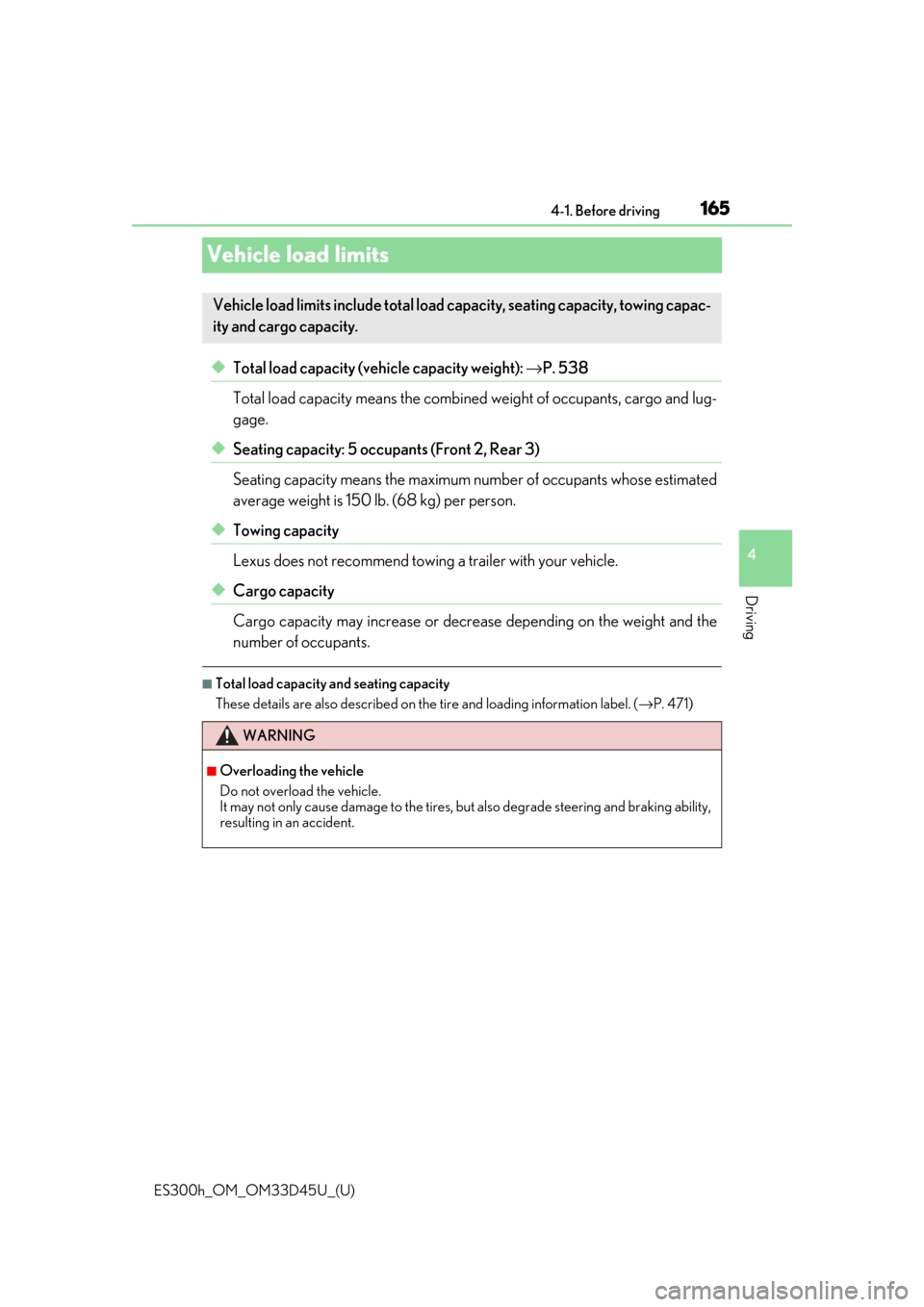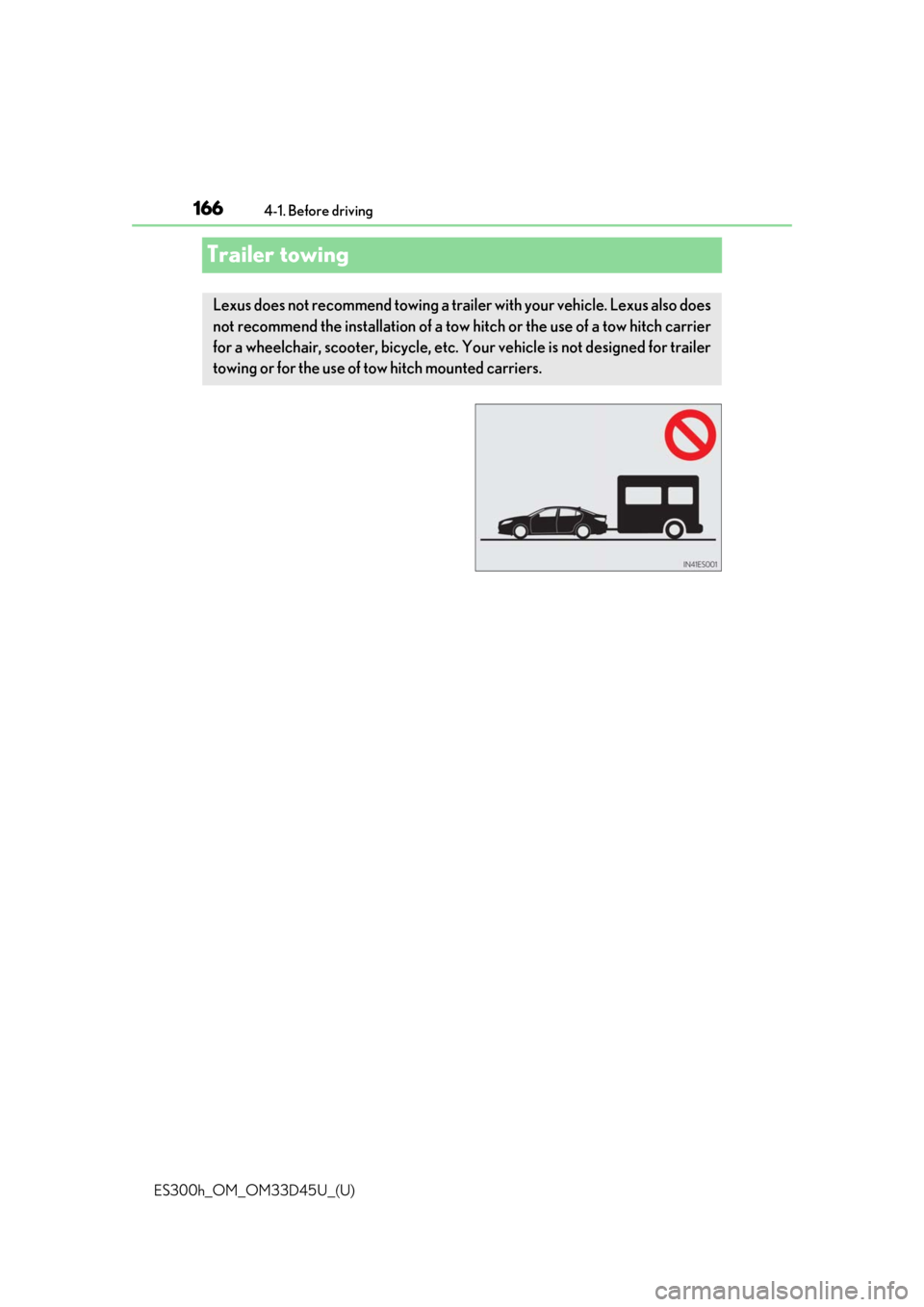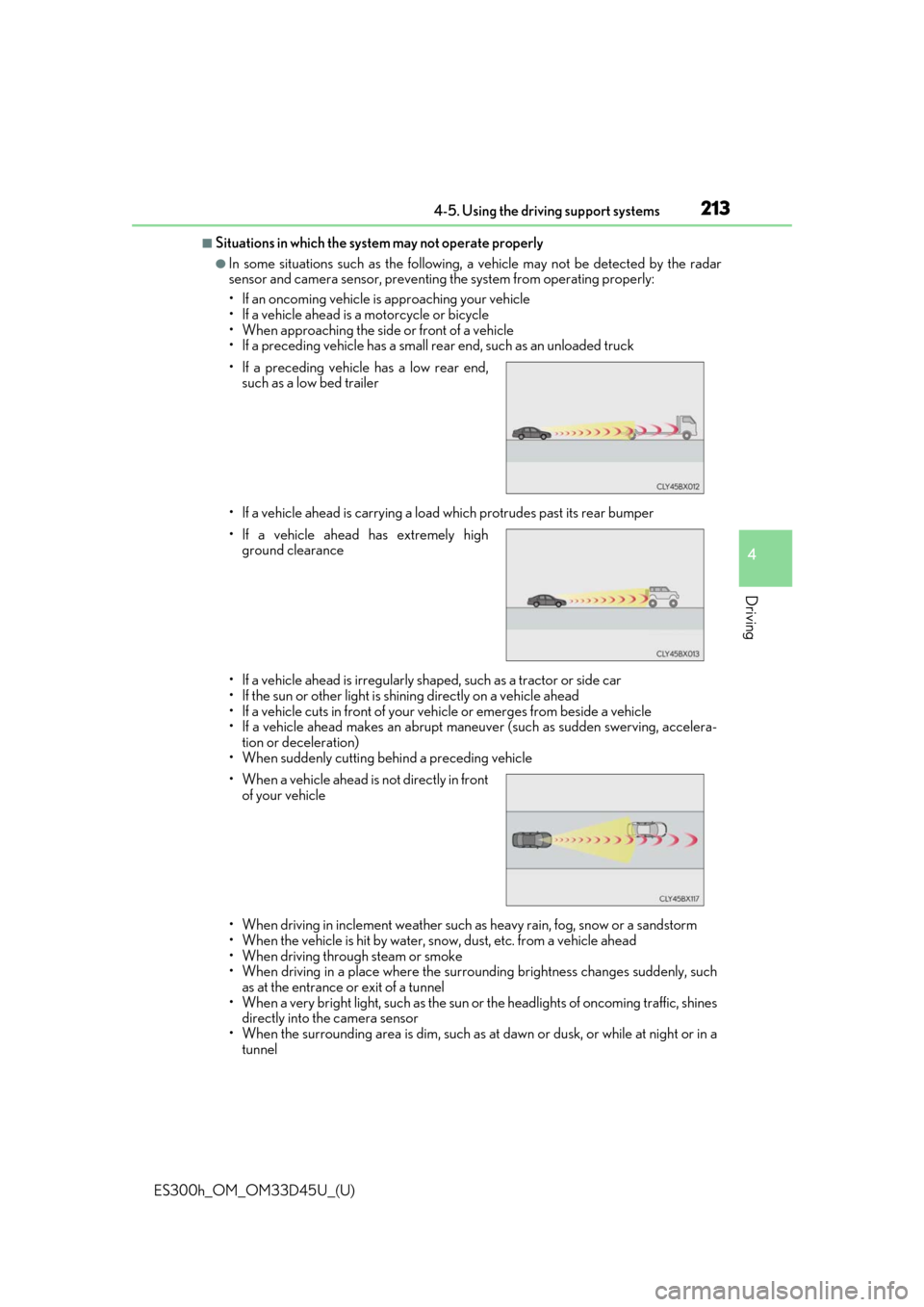trailer Lexus ES300h 2018 Owner's Manual (OM33D45U)
[x] Cancel search | Manufacturer: LEXUS, Model Year: 2018, Model line: ES300h, Model: Lexus ES300h 2018Pages: 608, PDF Size: 10.67 MB
Page 3 of 608

3
ES300h_OM_OM33D45U_(U)
1
9 8
7
6 4 3
2
10
5
4-1. Before drivingDriving the vehicle ......................154
Cargo and luggage ....................162
Vehicle load limits .......................165
Trailer towing ................................166
Dinghy towing ............................... 167
4-2. Driving procedures Power (ignition) switch............. 168
EV drive mode .............................. 173
Hybrid transmission....................175
Turn signal lever .......................... 180
Parking brake ................................. 181
4-3. Operating the lights and wipers
Headlight switch ......................... 182
Automatic High Beam.............. 185
Fog light switch ............................ 189
Windshield wipers and washer ................................. 190
4-4. Refueling Opening the fuel tank cap .......194 4-5. Using the driving support
systems
Lexus Safety System+ ............... 198
PCS (Pre-Collision System) ......... 205
LDA (Lane Departure Alert with steering co ntrol) .............. 216
Dynamic radar cruise control............................ 225
Intuitive parking assist.............. 237
Lexus parking assist monitor........................................ 246
Driving mode select switch ........................................... 262
BSM (Blind Spot Monitor)..... 264 •Blind Spot Monitor
function .....................................267
• Rear Cross Traffic Alert function .................................... 269
Driving assist systems ...............272
4-6. Driving tips Hybrid vehicle driving tips ..... 278
Winter driving tips.....................280
4Driving
Page 153 of 608

153
ES300h_OM_OM33D45U_(U)
4Driving
4-1. Before drivingDriving the vehicle ...................... 154
Cargo and luggage .................... 162
Vehicle load limits ....................... 165
Trailer towing ................................ 166
Dinghy towing .............................. 167
4-2. Driving procedures Power (ignition) switch ............. 168
EV drive mode ............................. 173
Hybrid transmission ................... 175
Turn signal lever...........................180
Parking brake ................................ 181
4-3. Operating the lights and wipers
Headlight switch .......................... 182
Automatic High Beam ..............185
Fog light switch ............................ 189
Windshield wipers and washer.................................. 190
4-4. Refueling Opening the fuel tank cap....... 194 4-5. Using the driving support
systems
Lexus Safety System+ ............... 198
PCS (Pre-Collision System) .........205
LDA (Lane Departure Alert with steering control) ..............216
Dynamic radar cruise control............................ 225
Intuitive parking assist .............. 237
Lexus parking assist monitor ........................................ 246
Driving mode select switch ........................................... 262
BSM (Blind Spot Monitor) ..... 264 • Blind Spot Monitor
function .................................... 267
• Rear Cross Traffic Alert
function .................................... 269
Driving assist systems .............. 272
4-6. Driving tips Hybrid vehicle driving tips ..... 278
Winter driving tips .....................280
Page 162 of 608

162
ES300h_OM_OM33D45U_(U)4-1. Before driving
Cargo and luggage
Cargo capacity depends on the total weight of the occupants.
(Cargo capacity) = (Total load capac
ity) — (Total weight of occupants)
Steps for Determining Correct Load Limit ⎯
(1) Locate the statement “The combined weight of occupants and cargo should
never exceed XXX kg or XXX lbs. ” on your vehicle’s placard.
(2) Determine the combined weight of th e driver and passengers that will be rid-
ing in your vehicle.
(3) Subtract the combined weight of th e driver and passengers from XXX kg or
XXX lbs.
(4) The resulting figure equals the ava ilable amount of cargo and luggage load
capacity.
For example, if the “XXX” amount equals 1400 lbs. and there will be five 150
lb passengers in your vehicle, the amou nt of available cargo and luggage load
capacity is 650 lbs. (1400 − 750 (5 × 150) = 650 lbs.)
(5) Determine the combined weight of luggage and cargo being loaded on the
vehicle. That weight may not safely exceed the available cargo and luggage
load capacity calculated in Step 4.
(6) If your vehicle will be towing a trailer, load from your trailer will be transferred
to your vehicle. Consult this manual to determine how this reduces the avail-
able cargo and luggage load capacity of your vehicle. ( →P. 165)
Lexus does not recommend towing a trailer with your vehicle. Your vehicle is not
designed for trailer towing.
Take notice of the following informat ion about storage precautions, cargo
capacity and load:
Capacity and distribution
Page 165 of 608

165
ES300h_OM_OM33D45U_(U)4-1. Before driving
4
Driving
Vehicle load limits
◆Total load capacity (vehicle capacity weight):
→P. 538
Total load capacity means the combined weight of occupants, cargo and lug-
gage.
◆Seating capacity: 5 occupants (Front 2, Rear 3)
Seating capacity means the maximum number of occupants whose estimated
average weight is 150 lb. (68 kg) per person.
◆Towing capacity
Lexus does not recommend towing a trailer with your vehicle.
◆Cargo capacity
Cargo capacity may increase or decrease depending on the weight and the
number of occupants.
■Total load capacity and seating capacity
These details are also described on the tire and loading information label. (→P. 471)
Vehicle load limits include total load capacity, seating capacity, towing capac-
ity and cargo capacity.
WARNING
■Overloading the vehicle
Do not overload the vehicle.
It may not only cause damage to the tires, but also degrade steering and braking ability,
resulting in an accident.
Page 166 of 608

166
ES300h_OM_OM33D45U_(U)4-1. Before driving
Trailer towing
Lexus does not recommend towing a trailer with your vehicle. Lexus also does
not recommend the installation of a tow
hitch or the use of a tow hitch carrier
for a wheelchair, scooter, bicycle, etc. Your vehicle is not designed for trailer
towing or for the use of tow hitch mounted carriers.
Page 187 of 608

ES300h_OM_OM33D45U_(U)
1874-3. Operating the lights and wipers
4
Driving
■Camera sensor detection information
●The high beam may not be automatically turned off in the following situations:
• When oncoming vehicles suddenly appear from a curve
• When the vehicle is cut in front of by another vehicle
• When vehicles ahead are hidden from sight due to repeated curves, road dividers or roadside trees
• When vehicles ahead appear from the faraway lane on wide road
• When vehicles ahead have no lights
●The high beam may be turned off if a vehicle ahead that is using fog lights without using
the headlights is detected.
●House lights, street lights, traffic signals, and illuminated billboards or signs may cause
the high beam to switch to the low beams, or the low beams to remain on.
●The following factors may affect the amount of time taken to turn the high beam on or
off:
• The brightness of headlights, fog lights, and tail lights of vehicles ahead
• The movement and direction of vehicles ahead
• When a vehicle ahead only has operational lights on one side
• When a vehicle ahead is a two-wheeled vehicle
• The condition of the road (gradient, cu rve, condition of the road surface etc.)
• The number of passengers and amount of luggage
●The high beam may be turned on or off when the driver does not expect it.
●Bicycles or similar objects may not be detected.
●In the situations shown below, the system may not be able to accurately detect sur-
rounding brightness levels. This may cause the low beams to remain on or the high
beams to cause problems for pedestrians, ve hicles ahead or other parties. In these
cases, manually switch between the high and low beams.
• In bad weather (rain, snow, fog, sandstorms etc.)
• The windshield is obscured by fog, mist, ice, dirt etc.
• The windshield is cracked or damaged.
• The camera sensor is deformed or dirty.
• The camera sensor temperature is extremely high.
• Surrounding brightness levels are equal to th ose of headlights, tail lights or fog lights.
• Vehicles ahead have headlights or tail lights that are either switched off, dirty, are
changing color, or are not aimed properly.
• When driving through an area of intermittently changing brightness and darkness.
• When frequently and repeated ly driving ascending/descending roads, or roads with
rough, bumpy or uneven surfaces (such as stone-paved roads, gravel tracks etc.).
• When frequently and repeatedly taking curves or driving on a winding road.
• There is a highly reflective object ahead of the vehicle, such as a sign or a mirror.
• The back of a vehicle ahead is highly re flective, such as a container on a truck.
• The vehicle’s headlights are damaged or dirty, or are not aimed properly.
• The vehicle is listing or tilting due to a flat tire, a trailer being towed, etc.
• The high beam and low beam are repeated ly being switched between in an abnor-
mal manner.
• The driver believes that the high beam may be causing problems or distress to other drivers or pedestrians nearby.
Page 213 of 608

ES300h_OM_OM33D45U_(U)
2134-5. Using the driving support systems
4
Driving
■Situations in which the system may not operate properly
●In some situations such as the following, a vehicle may not be detected by the radar
sensor and camera sensor, preventing the system from operating properly:
• If an oncoming vehicle is approaching your vehicle
• If a vehicle ahead is a motorcycle or bicycle
• When approaching the side or front of a vehicle
• If a preceding vehicle has a small rear end, such as an unloaded truck
• If a vehicle ahead is carrying a load which protrudes past its rear bumper
• If a vehicle ahead is irregularly shap ed, such as a tractor or side car
• If the sun or other light is shin ing directly on a vehicle ahead
• If a vehicle cuts in front of your ve hicle or emerges from beside a vehicle
• If a vehicle ahead makes an abrupt maneuver (such as sudden swerving, accelera-
tion or deceleration)
• When suddenly cutting behind a preceding vehicle
• When driving in inclement we ather such as heavy rain, fog, snow or a sandstorm
• When the vehicle is hit by water, sn ow, dust, etc. from a vehicle ahead
• When driving through steam or smoke
• When driving in a place where the surrounding brightness changes suddenly, such as at the entrance or exit of a tunnel
• When a very bright light, such as the sun or the headlights of on coming traffic, shines
directly into the camera sensor
• When the surrounding area is dim, such as at dawn or dusk, or while at night or in a tunnel
• If a preceding vehicle has a low rear end,
such as a low bed trailer
• If a vehicle ahead has extremely high ground clearance
• When a vehicle ahead is not directly in front of your vehicle
Page 218 of 608

218
ES300h_OM_OM33D45U_(U)4-5. Using the driving support systems
WARNING
■Before using LDA system
Do not rely solely upon the LDA system. The LDA system does not automatically drive
the vehicle or reduce the amount
of attention that must be paid to the area in front of
the vehicle. The driver must always assume full responsibility for driving safely by pay-
ing careful attention to the surrounding cond itions and operating the steering wheel to
correct the path of the vehicle. Also, the driver must take adequate breaks when
fatigued, such as from driving for a long period of time.
Failure to perform appropriate driving operat ions and pay careful attention may lead to
an accident, resulting in death or serious injury.
■To avoid operating LDA system by mistake
When not using the LDA system, use the LDA switch to turn the system off.
■Situations unsuitable for LDA system
Do not use the LDA system in the following situations.
The system may not operate properly and lead to an accident, resulting in death or
serious injury.
●A spare tire, tire chains, etc. are equipped.
●When the tires have been excessively worn, or when the tire inflation pressure is low.
●Tires which differ by structure, manufacturer, brand or tread pattern are used.
●Objects or patterns that could be mistaken for white (yellow) lines are present on the
side of the road (guardrails, cu rbs, reflective poles, etc.).
●Vehicle is driven on a snow-covered road.
●White (yellow) lines are difficult to see due to rain, snow, fog, dust, etc.
●Asphalt repair marks, white (yellow) line marks, etc. are present due to road repair.
●Vehicle is driven in a temporary lane or restricted lane due to construction work.
●Vehicle is driven on a road surface which is slippery due to rainy weather, fallen snow,
freezing, etc.
●Vehicle is driven in traffic lanes ot her than on highways and freeways.
●Vehicle is driven in a construction zone.
●Vehicle is towing a trailer or another vehicle.
■Preventing LDA system malfunctions and operations performed by mistake
●Do not modify the headlights or place stickers, etc. on the surface of the lights.
●Do not modify the suspension etc. If the suspension etc. needs to be replaced, con-
tact your Lexus dealer.
●Do not install or place anything on the hood or grille. Also, do not install a grille guard
(bull bars, kangaroo bar, etc.).
●If your windshield needs repair s, contact your Lexus dealer.
Page 603 of 608

603Alphabetical index
ES300h_OM_OM33D45U_(U)
TiresChains....................................................... 281
Checking................................................. 461
If you have a flat tire ........................... 513
Inflation pressure ............................... 545
Information ........................................... 550
Replacing ................................................ 513
Rotating tires ......................................... 461
Size ........................................................... 545
Snow tires ............................................. 283
Spare tire ................................................. 513
Tire inflation pressure display function ................................................... 92
Tire pressure warning system .....462
Warning light ...................................... 505
Tools.............................................................514
Top tether strap........................................ 63
Total load capacity .................................165
Towing Dinghy towing .......................................167
Emergency towing........................... 498
Towing eyelet...................................... 500
Trailer towing ........................................ 166
TRAC (Traction Control) ..................272
Traction battery (hybrid battery) ........ 71
Traction motor (electric motor) .......... 71
Transmission Driving mode select switch .......... 262
Hybrid transmission........................... 175
If the shift lever cannot be shifted from P .................................... 178
Trip information........................................ 87
Trip meters ................................................. 86 Trunk
Internal trunk release lever .............. 116
Jam protection function..................... 116
Luggage security system.................. 115
Power trunk opener and closer .....114
Smart access system with push-button start......................114
Trunk closer switch.............................. 115
Trunk easy closer ................................. 116
Trunk features......................................403
Trunk handle ........................................... 115
Trunk light................................................. 116
Trunk opener main switch ............... 115
Trunk opener switch ............................114
Wireless remote control................. 108
Trunk light Trunk light................................................. 116
Wattage ................................................. 546
Turn signal lights Replacing light bulbs ............................ 487, 490, 492
Turn signal lever .................................. 180
Wattage ................................................. 546
USB memory
*...................................... 295
U
*: For vehicles with navigation system, refer to the
“NAVIGATION SYSTEM OWNER’S MANUAL”.